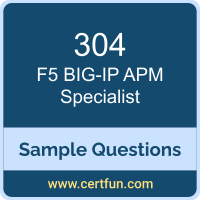01. In a Single Logout (SLO) scenario, what mechanism is typically used to inform the IdP that the user has logged out of the SP?
a) The SP sends an HTTP POST request to the IdP's logout endpoint.
b) The user's browser automatically sends a logout request to the IdP.
c) The IdP periodically polls the SP to check for user logout status.
d) The user manually logs out of the IdP after logging out of the SP.
02. How can administrators perform basic customizations of the BIG-IP APM user interface without affecting access policies?
(Select all that apply)
a) Editing the HTML code of the logon page
b) Using iRules to manipulate the login process
c) Enabling strict updates for the access profiles
d) Modifying the Cascading Style Sheets (CSS) of the web portal
03. To configure BIG-IP APM as a Service Provider (SP) with an external vendor IdP, what information is typically exchanged between the two systems to establish trust?
a) A shared secret for encrypting SSO requests and responses.
b) An SSL certificate for secure communication between SP and IdP.
c) Metadata containing SP and IdP configuration details.
d) A session token for maintaining user state during the SSO process.
04. Which procedural concepts are essential for maintaining iApps?
(Select all that apply)
a) Regularly updating the iApp template files
b) Monitoring application traffic using the BIG-IP device
c) Backing up iApp configurations and templates
d) Periodically reviewing iApp documentation
05. In which scenarios is it appropriate to enable strict updates in an iApp configuration?
(Select all that apply)
a) When regularly updating the iApp template files
b) When deploying critical application services that require high availability
c) When needing to prevent manual changes to a deployed application service
d) When deploying an iApp on a test or development environment
06. To configure TACACS as an AAA method on BIG-IP APM, which of the following is required?
a) A pre-shared key for secure communication with the TACACS server.
b) An SSL certificate issued by the TACACS server.
c) A user account on the BIG-IP APM with administrator privileges.
d) A RADIUS server configured as a fallback authentication method.
07. What should be analyzed and correlated when troubleshooting a failure in BIG-IP APM to determine the root cause?
a) Session reports, session variables, and application response times
b) TCPdump data, APM log, and client-side error messages
c) BIG-IP system logs, SSL handshake details, and virtual server configurations
d) EPSEC status codes, session timeouts, and access policy configurations
08. When would you need to use a Layer 4 ACL in BIG-IP APM instead of a Layer 7 ACL?
a) When filtering traffic based on source IP addresses only
b) When enforcing access policies based on user roles and groups
c) When inspecting application data and URL patterns
d) When configuring IP Intelligence for GeoIP-based access controls
09. What is the primary use case of a Secure Web Gateway (SWG) in BIG-IP APM deployments?
a) To protect resources from DDoS attacks
b) To provide web filtering and content security services
c) To enforce access policies for specific user groups
d) To enable Multi-Factor Authentication (MFA) for user logins
10. How does BIG-IP APM handle Access Policy Sync to ensure consistency across HA devices?
a) It synchronizes access policies globally for all virtual servers.
b) It requires manual configuration for local objects on each device.
c) It synchronizes access policies locally within each traffic group.
d) It uses DNS-based synchronization for global policy settings.
 Getting knowledge of the F5 304 exam structure and question format is vital in preparing for the F5 BIG-IP APM Specialist certification exam. Our F5 BIG-IP APM Specialist sample questions offer you information regarding the question types and level of difficulty you will face in the real exam. The benefit of using these F5 304 sample questions is that you will get to check your preparation level or enhance your knowledge by learning the unknown questions. You will also get a clear idea of the exam environment and exam pattern you will face in the actual exam with the F5 BIG-IP APM Specialist Sample Practice Test. Therefore, solve the F5 BIG-IP APM sample questions to stay one step forward in grabbing the F5 Certified Technology Specialist - BIG-IP APM credential.
Getting knowledge of the F5 304 exam structure and question format is vital in preparing for the F5 BIG-IP APM Specialist certification exam. Our F5 BIG-IP APM Specialist sample questions offer you information regarding the question types and level of difficulty you will face in the real exam. The benefit of using these F5 304 sample questions is that you will get to check your preparation level or enhance your knowledge by learning the unknown questions. You will also get a clear idea of the exam environment and exam pattern you will face in the actual exam with the F5 BIG-IP APM Specialist Sample Practice Test. Therefore, solve the F5 BIG-IP APM sample questions to stay one step forward in grabbing the F5 Certified Technology Specialist - BIG-IP APM credential.